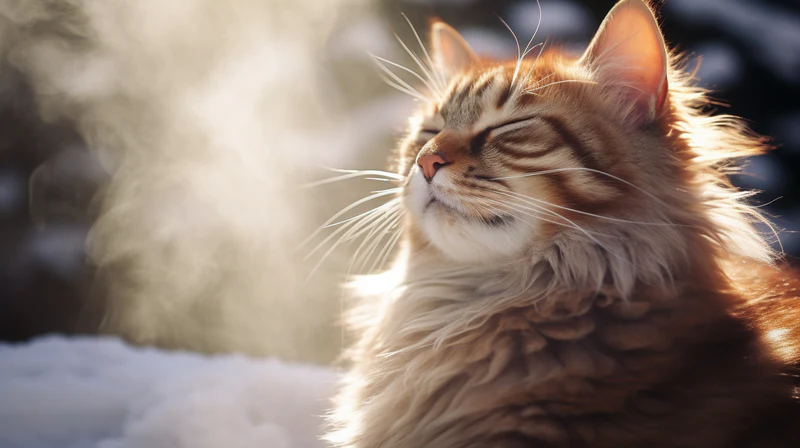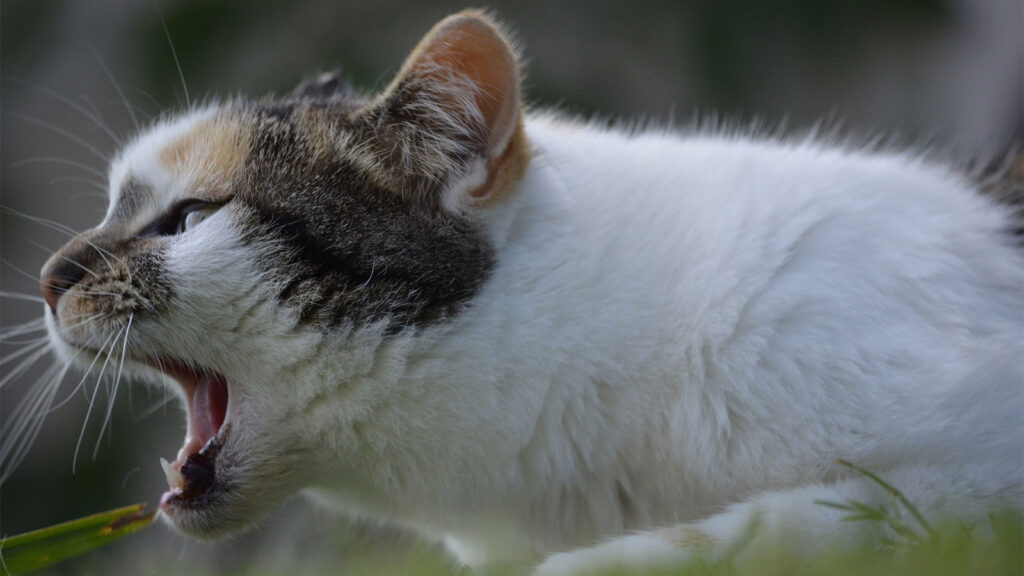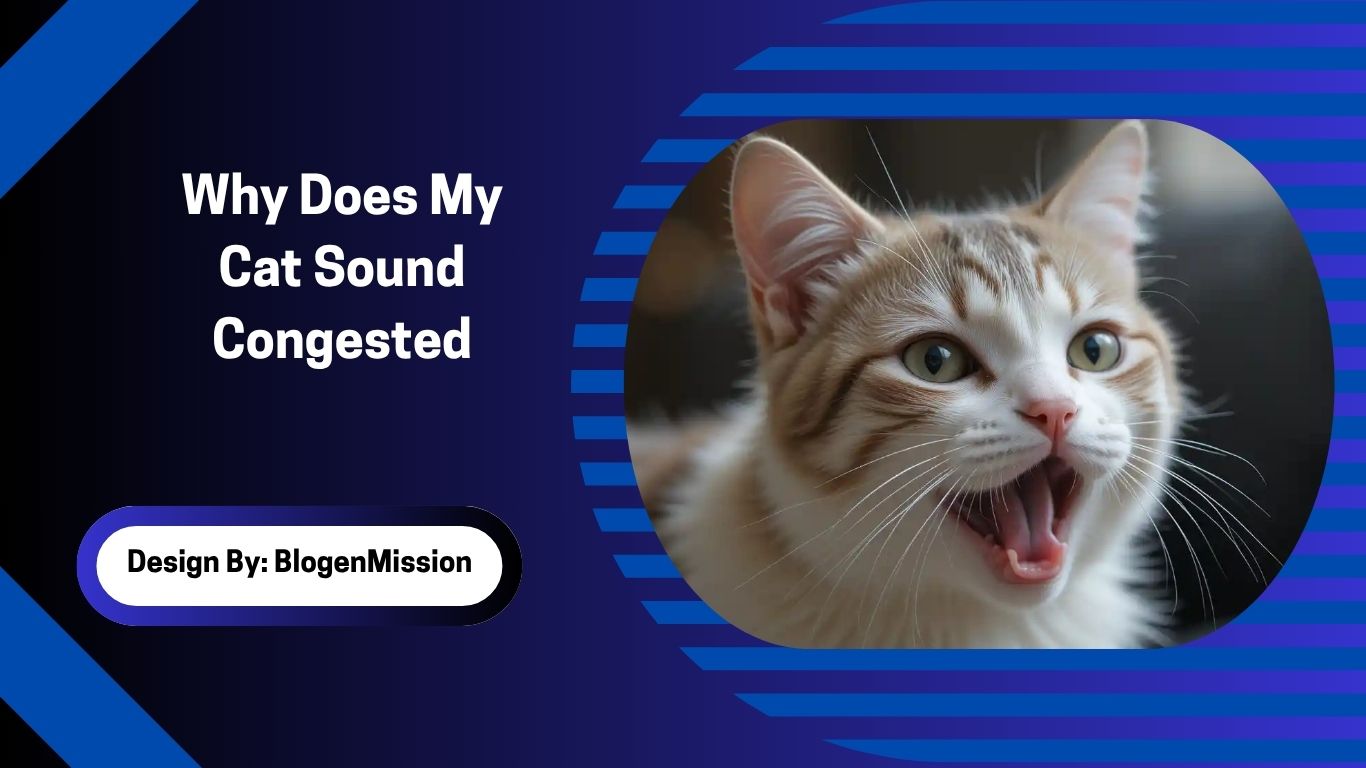A cat sounding congested may be experiencing upper respiratory infections, allergies, asthma, dental issues, or more serious conditions like heart disease. Identifying the cause early is key to effective treatment and recovery.
Is your cat making strange snoring, wheezing, or rattling sounds when breathing? If so, you’re probably asking yourself, “Why does my cat sound congested?” Noisy or labored breathing in cats can range from minor issues like allergies to more serious respiratory or cardiac conditions.
This in-depth guide breaks down the possible causes, symptoms to monitor, and how to support your feline at home or through veterinary care.
What Does Congested Breathing Sound Like in Cats?
Cats typically breathe quietly through their noses. When something interferes with the airways, it may result in audible breathing. These sounds include:
- Stertor – A low-pitched snoring or gurgling noise often caused by nasal or upper airway blockages.
- Stridor – A high-pitched wheezing sound caused by obstruction or narrowing in the throat or windpipe.
- Wheezing – Whistling or squeaking noises heard especially when the cat exhales, often due to asthma or bronchitis.
- Rattling or wet sounds – These may suggest fluid buildup or infection in the lungs.
If your cat sounds congested when resting, sleeping, or after mild exertion, it may indicate an issue needing attention.
Common Reasons Why Your Cat Sounds Congested

1. Upper Respiratory Infections (URIs)
One of the most frequent causes, URIs are similar to the common cold in humans. They’re often caused by feline herpesvirus or calicivirus and lead to symptoms like:
- Sneezing
- Runny nose
- Congestion
- Watery or goopy eyes
- Reduced appetite
Secondary bacterial infections may develop, worsening the congestion and requiring antibiotics.
2. Allergies or Irritants
Environmental allergens like pollen, dust mites, mold, cigarette smoke, perfumes, and household cleaning agents can trigger sneezing, nasal inflammation, and noisy breathing. Cats may show symptoms such as:
- Sniffling
- Watery eyes
- Nasal discharge
- Increased grooming due to itchiness
Removing the allergen source and using HEPA filters can help reduce symptoms.
3. Nasal Polyps or Tumors
Benign growths (polyps) or more serious tumors can block airflow through the nasal passages, leading to a snorting or snoring sound. Other signs may include:
- Frequent sneezing
- Blood-tinged discharge
- Noisy breathing on one side
- Head shaking or pawing at the face
A vet may use rhinoscopy (a small camera) to locate and biopsy these growths.
4. Feline Asthma
Asthma is a chronic inflammatory disease of the lower airways that causes wheezing, coughing, and labored breathing. Cats with asthma may crouch down, extend their necks, and breathe with difficulty, especially after exercise or exposure to allergens.
Asthma can be managed with bronchodilators and corticosteroids, often through inhalers designed for cats.
5. Dental Disease
Severe dental infections or abscesses in the upper jaw can erode into the sinuses, leading to chronic nasal drainage and congestion. Look for signs like:
- Drooling
- Bad breath
- Difficulty eating
- Facial swelling
Proper dental care, including cleanings and possible extractions, is essential.
6. Heart Disease
Congestive heart failure can cause fluid to accumulate in the lungs (pulmonary edema), making breathing difficult and noisy. Other symptoms may include:
- Open-mouth breathing
- Lethargy
- Coughing
- Poor appetite
This condition requires immediate veterinary evaluation and may be managed with medications and dietary changes.
7. Foreign Body or Obstruction
In rare cases, cats may inhale foreign material (like grass seeds or small toys) that becomes lodged in the nasal passage or airway, causing stridor or persistent sneezing. Emergency removal may be needed.
When to Be Concerned: Red Flags
You should contact your vet promptly if your cat shows any of the following symptoms:
- Open-mouth or rapid breathing
- Blue or pale gums
- Nasal discharge that is green, yellow, or bloody
- Visible effort to breathe
- Loss of appetite or lethargy
- Weight loss
- Persistent coughing or wheezing
- Noisy breathing during sleep
These could indicate serious respiratory distress, infection, or underlying conditions that require prompt treatment.
Diagnosing the Cause of Congestion
Veterinarians use a variety of tools to identify the reason for your cat’s noisy breathing:
- Physical exam: Listening to lung and airway sounds
- Blood tests: To assess infection or inflammation
- X-rays or ultrasound: To check lungs, heart, and sinuses
- Endoscopy or rhinoscopy: Visual examination of nasal passages
- Swabs or biopsies: To identify viruses, bacteria, or abnormal cells
A diagnosis allows your vet to prescribe targeted treatments.
Home Care for Mild Congestion

If your cat is alert, eating, and only mildly congested, some home remedies may help:
- Use a humidifier: Moist air helps clear nasal passages.
- Steam therapy: Let your cat sit in a steamy bathroom for 10–15 minutes.
- Clean environment: Minimize dust, smoke, and chemical exposure.
- Elevate food bowls: This can make swallowing and breathing easier.
- Warm, moist food: Encourages hydration and appetite.
- Nasal cleaning: Gently wipe away discharge using a warm, damp cloth.
Never use human medications unless prescribed by a vet. Even common over-the-counter decongestants can be fatal to cats.
Preventive Tips to Avoid Future Congestion
- Keep your cat indoors to limit exposure to pathogens and allergens.
- Regularly clean bedding, litter boxes, and food bowls.
- Stay up to date with vaccines, especially for feline herpesvirus.
- Schedule regular dental checkups.
- Provide high-quality food to support immunity.
- Use natural cleaners that are safe for pets.
Can Congested Breathing Be Serious?
Yes. While mild cases often resolve with care, underlying causes like heart disease, pneumonia, tumors, or chronic asthma can pose serious health risks. Early diagnosis increases the chance of successful treatment and recovery.
FAQs:
1. Can a cat sound congested without being sick?
Yes, cats can sound congested due to non-illness-related issues like dust, allergies, or nasal polyps. However, persistent noisy breathing should be evaluated to rule out infections or more serious health concerns.
2. Should I be worried if my cat breathes loudly when sleeping?
Occasional loud breathing may be harmless, but consistent nighttime congestion or wheezing can indicate upper airway blockages or chronic respiratory problems. Monitor symptoms and consult a vet if it continues or worsens.
3. Can cat congestion go away on its own?
Mild congestion caused by allergies or a minor cold may resolve without treatment. However, if symptoms last more than a few days or worsen, veterinary care is recommended to prevent complications.
4. How can I tell if my cat has a respiratory infection?
Common signs include sneezing, nasal discharge, watery eyes, reduced appetite, and fatigue. If your cat shows multiple symptoms or labored breathing, seek prompt veterinary attention to confirm and treat the infection.
5. What home remedies help cats with nasal congestion?
Use a humidifier, offer steam therapy in the bathroom, serve warm moist food, and wipe discharge with a warm cloth. Always avoid human medications and consult your vet before trying new remedies.
Conclusion:
Congested breathing in cats can result from a range of causes, from harmless irritants to serious medical conditions. While minor congestion may pass on its own, prolonged or worsening symptoms require veterinary evaluation. Being attentive to changes in your cat’s breathing patterns, appetite, and energy levels helps ensure early detection and appropriate treatment. Supporting your cat with a clean, low-allergen environment and seeking professional care when needed can greatly improve their respiratory health and overall quality of life.
Related Post:
- How Often Should Cats Get Rabies Shots – You Need to Know!
- Cat Food Canned – Ultimate Guide!
- Why Is My Cat Not Drinking Water – Causes, Risks & Solutions!
